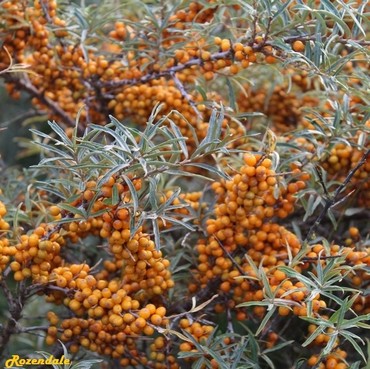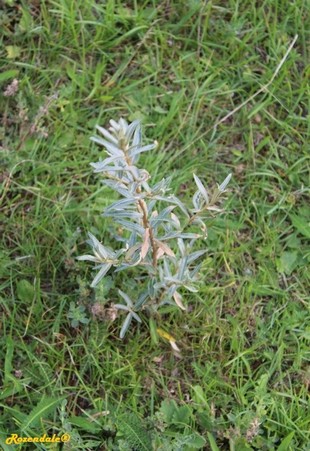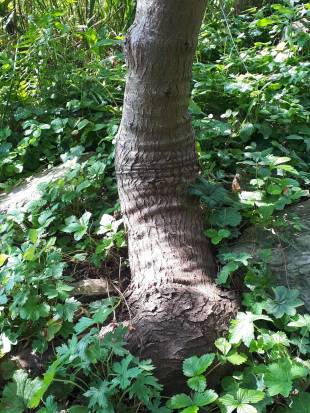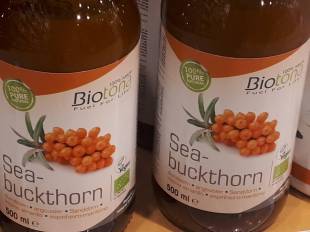Sidebar
Hippophae rhamnoides - Seabuck-thorn
Description and Uses
Hippophae rhamnoides (Seabuck-thorn) is a temperate shrub from North West Europe . It is mainly grown for its fruit crops , which have a short shelf life. The crop is harvested by hand picking. It starts flowering after 3 - 4 years. The yield will be {missing data}, but in its top season there will be a yield of {missing data}. Other crop types include; fertilization, oil, fruit, fuel, alcohol, ornamental, The fruit is used as super food . The fruit is used as " high vitamin-C content, " with {missing data} ({missing data} - {missing data}) as its significant phytochemical. There is Seabuckthorn oil extracted by centrifugal extraction from the shrub's fruit yielding {missing data} - {missing data} oil. The shrub's wood is called seabuck-thorn wood and has a density of 400 - 400 kg/m³. Regarding firewood production the shrub's growing speed is moderate, it's energetic value is 4670 ckal/kg and the wood's drying speed is medium. After 9 years the shrub can be totally removed as it reached its commercial and ecological goal. Hippophae rhamnoides has a lifespan of 45 years.
Environmental limitations
The shrub is
16 meters tall with a crown of
10 meters wide. The
shrub prefers a planting distance of
100 cm and a row distance of
400 cm. It is
moderate fast growing and
intolerant to shade.
Hippophae rhamnoides has a
deep root-system and it has symbiotic associations with the
fungi
(endo-mycorrhiza). It is
able to fix nitrogen moderately with
"Frankiaceae bacteria. The name(s) or string of bacteria include(s)
"Frankia alni ". The
shrub's flower-morphology is
dioecious and is pollinated by
wind.
Hippophae rhamnoides is
{missing data} and
a bit allelopathic and has
no thorns.
Hippophae rhamnoides thrives in an altitude of
0 to
5200 meters above sea-level
(temperate). The minimum temperature is
-15°C; optimally between
7 -
22°C. The optimal rainfall is
650
mm/year. Without irrigation the annual rainfall should be between
250 -
800mm (L/m²). The optimal soil-pH is between
8.0 -
10.0 in a soil texture of
sand. To salt it is
very tolerant to wind
tolerant and to fire
a bit tolerant.
Pests and Diseases
Hippophae rhamnoides is susceptible to the following pests: . And it's susceptible to the following diseases: (missing data) , , .
Seed Propagation
Seeds are stratificant and can be stored for 36 months. There are approximative 0 seeds/kg. The seeds can be propagated as followed:
- (1) Store harvested seeds moisty at a chilling temperature of 3-7 degrees C for 2-4 months
- (2) Soak the seeds overnight in warm water before sowing.
- (3) Remove the seeds from cold to a permanent warm temperature.
| Vertical Photo [+] |

|
Katwijk aan Zee, Netherlands - 2017-08-18 |
| Seeds Photo [+] [Buy Seeds] |

|
Rijs, Netherlands - 2019-12-10 |
| Detail Photo [+] [Mother Plants] |

|
Katwijk aan Zee, Netherlands - 2017-08-17 |
| Seedling Photo [+] [Buy Seedlings] |

|
Katwijk aan Zee, Netherlands - 2017-05-06 |
| Stem Photo [+] |

|
Haren, Netherlands - 2018-09-01 |
| [Crops Photos] [+] [Buy Crops] |

|
, - |
| * |
- Botanical Taxonomy - |
|
|---|---|
|
Clade
[+] Order [+] Family [+] Sub-family [+] Species Common name |
Rosids Rosales Elaeagnaceae Elaeagnoideae Hippophae rhamnoides Seabuck-thorn |

|
|---|
| Parameter | Rating |
|---|---|
|
Fruit Nut Apiculture Fodder Medicinal Oil Timber Grow-speed Firewood |
|
See also |
|
|---|---|